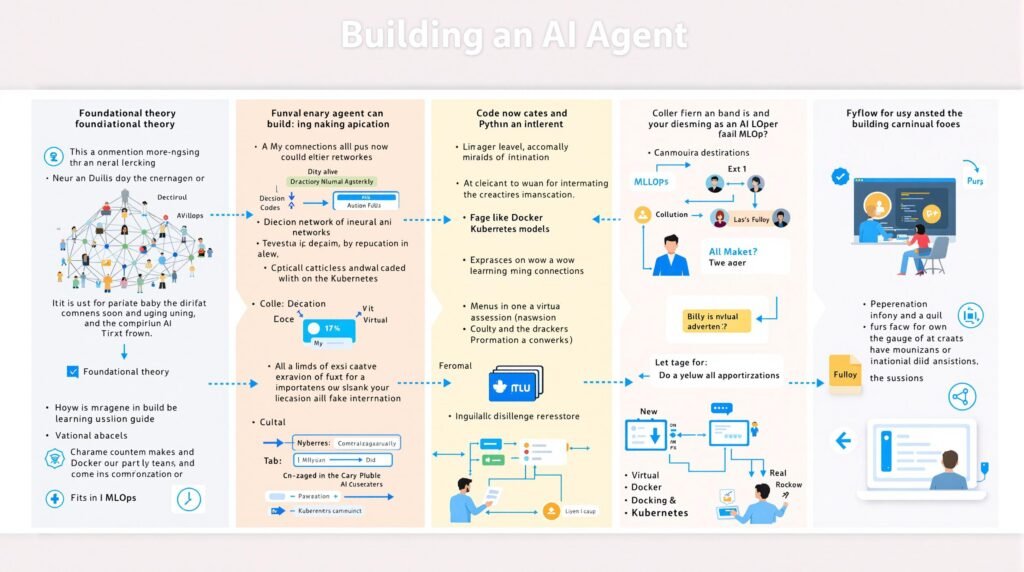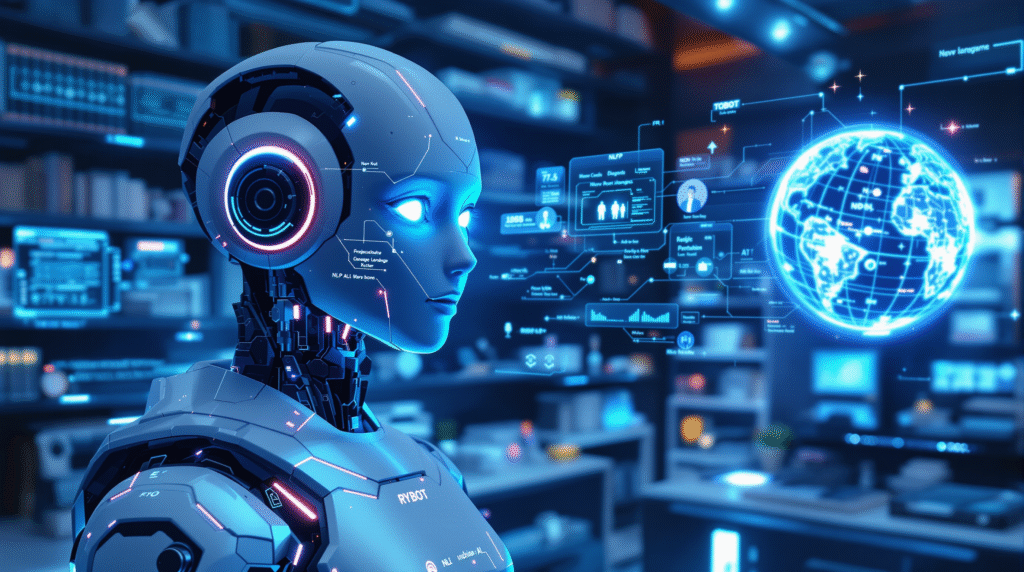Introduction: AI Agents – What Are They and Why Should You Get to Know Them?
AI agents are one of the most important elements of modern artificial intelligence. These are programs or systems that can independently observe their environment, analyze data, and make decisions to achieve a specific goal. AI agents can operate in the real world (e.g., robots, smart homes) or in the virtual world (e.g., chatbots, recommendation systems).
Why should you get to know AI agents? Above all, because we encounter them more and more often in everyday life—from voice assistants in smartphones, through recommendation systems in online stores, to autonomous vehicles. Understanding how AI agents work not only allows you to make better use of modern technologies but also to create your own innovative solutions that can improve work, learning, or entertainment.
Theory: Basic Concepts, Architecture, and Types of AI Agents
To understand how AI agents work, it’s worth getting to know a few key concepts:
Environment – everything that surrounds the agent and with which it can interact (e.g., user, other devices, data from the internet).
Perception – the agent’s ability to receive information from the environment (e.g., sensor readings, user text).
Action – the agent’s reaction to stimuli from the environment (e.g., sending a response, turning on the light).
Goal – the task the agent is supposed to accomplish (e.g., maintaining temperature, providing the correct answer).
The architecture of an AI agent usually consists of several modules: perception (data collection), analysis (processing and decision-making), and action (executing the chosen action). More advanced agents may also have a learning module, which allows them to improve their decisions based on experience.
There are different types of AI agents:
Reactive agents – act based on current stimuli, without memory of the past.
Agents with limited memory – remember some information from the past, which allows them to better respond to recurring situations.
Learning agents – use machine learning algorithms to improve their actions.
Multi-agent systems – cooperate with other agents, exchanging information and accomplishing tasks together.
Planning: Defining the Agent’s Goal, Environment, and Capabilities
Before you start programming your own AI agent, it’s worth carefully planning its functions and how it will operate. Key questions to answer at the beginning include:
What is the agent’s goal? Consider what task your agent is supposed to perform. This could be, for example, answering user questions, monitoring temperature, recommending products, or analyzing data.
In what environment will the agent operate? Determine whether the agent will function in the real world (e.g., controlling IoT devices), in a virtual world (e.g., a chatbot on a website), or in a simulation.
What data and tools will be available? Consider where the agent will get information from (e.g., sensors, databases, APIs) and what technologies you want to use (e.g., Python, AI libraries).
What capabilities and limitations will the agent have? Determine whether the agent should learn from data or operate according to established rules, how often it should make decisions, and what actions it can perform.
Good project planning will help you avoid many problems during the implementation phase and will make your AI agent effective and useful. Planning is the foundation of every successful project—the more time you spend on this stage, the easier it will be for you to move on to practical implementation.
Implementation: Step by Step, Creating a Simple Agent in Python
After planning the architecture and defining the agent’s goal, it’s time to move on to practical implementation. The best way to learn is to create a simple agent in Python. Below you’ll find an example of an agent that decides whether to turn on a fan based on the room temperature.
python
Copy Code
class FanAgent:
def __init__(self, temp_threshold):
self.temp_threshold = temp_threshold
def observe_and_act(self, current_temp):
if current_temp > self.temp_threshold:
return „Turn on the fan”
else:
return „Fan off”
# Example usage
agent = FanAgent(temp_threshold=25)
print(agent.observe_and_act(current_temp=28)) # Turn on the fan
print(agent.observe_and_act(current_temp=22)) # Fan off
In this example, the agent has a set temperature threshold. If the room temperature exceeds this threshold, the agent decides to turn on the fan. Otherwise, the fan remains off. This is a very simple model, but it clearly illustrates the basic agent cycle: observation, analysis, and action.
Testing: Checking Correct Operation and Detecting Errors
After writing the first version of your agent, it is extremely important to test it. Testing involves checking how the agent reacts to different input data and whether it makes the right decisions. In the example above, you can test the agent by providing different temperature values and checking if it turns the fan on or off accordingly.
It’s also worth checking how the agent behaves in unusual situations, such as very high or very low temperatures, and whether it correctly handles incorrect input data. Testing allows you to detect potential errors and ensure that the agent will work reliably in practice.
A good practice is to gradually expand your tests as the agent develops—the more advanced the project, the more scenarios you should check.
Learning: Introduction to Machine Learning and Algorithms
After creating and testing a simple agent, it’s worth considering how to make it more intelligent and autonomous. This is where machine learning comes in. Thanks to it, the agent can analyze data, recognize patterns, and learn from experience, instead of acting solely according to rigid rules.
The most popular machine learning techniques include:
Supervised learning – the agent learns from input data and known answers (e.g., classifying emails as spam or not spam).
Unsupervised learning – the agent independently discovers patterns in the data (e.g., grouping customers by purchasing behavior).
Reinforcement learning – the agent learns through interaction with the environment, receiving rewards for good decisions and penalties for bad ones.
In Python, libraries such as scikit-learn, TensorFlow, or PyTorch are most often used to implement machine learning algorithms. Thanks to them, you can build an agent that will develop and adapt to new situations.
Optimization: Improving the Agent’s Performance, Scalability, and Security
When your agent is working correctly and can learn, it’s worth thinking about its optimization. Optimization covers several key aspects:
Performance – check if the agent works quickly and does not consume too many resources. You can improve performance by optimizing the code, using more efficient algorithms, or using parallel processing.
Scalability – if your agent is to support many users or large amounts of data, ensure that it is easy to increase computing power (e.g., by deploying in the cloud).
Security – AI agents often process sensitive data, so it is important to secure access, encrypt information, and comply with data protection regulations (e.g., GDPR).
Optimization is an ongoing process—it’s worth regularly monitoring the agent’s performance, analyzing its results, and making improvements to make it more and more effective and reliable.
Application Examples: Inspirations and Ideas for Your Own Projects
AI agents are used in many areas of life and business. Here are some inspiring examples that can become a starting point for your own projects:
Chatbots and virtual assistants – help with customer service, answer questions, book appointments, or support users in everyday tasks.
Recommendation systems – suggest products, movies, music, or articles based on the user’s previous choices.
Smart home systems – control lighting, heating, security, or energy consumption in the home.
Data analysis agents – automatically process and interpret large data sets, detecting trends, anomalies, or generating reports.
Agents in education – personalize the learning process by adjusting materials and pace to the individual needs of the student.
Each of these examples can be expanded by adding new features, integrating with other systems, or using advanced machine learning algorithms.
Summary: AI Agents – From Theory to Practice, Step by Step
Creating your own AI agents is a process that starts with understanding the theoretical basics and ends with practical, working solutions. With proper planning, tool selection, testing, learning, and optimization, even a beginner programmer can create an agent that genuinely makes life easier or solves a specific problem.
Remember that the world of AI is developing very dynamically, and the possibilities for agents are constantly growing. Every new project is an opportunity for learning and development—both technical and creative. Don’t be afraid to experiment, ask questions, and look for inspiration. AI agents are the technology of the future, and they are already within your reach today!


